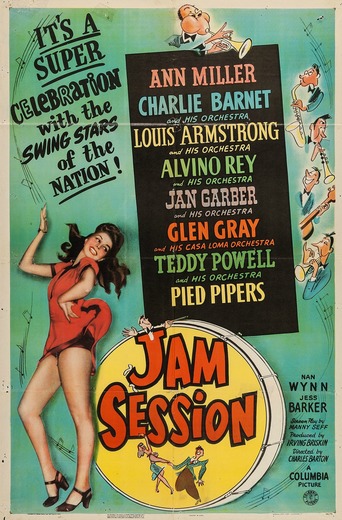mark.waltz
Tap dance contest winner Ann Miller arrives in Hollywood hoping to get a studio contract and become a movie musical star. That's pretty much it for plot in addition to western star Jess Barker's interest in her. Like Reviles with Beverly, this is a collection of musical numbers collected into a single plot line, but when you got the amount of talent that this film engages, the results are going to be extremely entertaining to say the least. Being World War 2, the housing shortage is on, even in Hollywood and Annie has a hysterical predicament and trying to find a room which leads to the discovery of the one that is available. Louis Armstrong has a cameo at the beginning singing I can't give you anything but love, which Annie would later sing with Mickey Rooney on Broadway in Sugar Babies. There's a hysterical sequence where she disguises herself as an old lady to sneak into what is presume to be Columbia Studios to get an audition, and revealed herself to be wearing very little makeup even under her disguise. Practically every musical had a polka to go with it, and here it's the Victory Polka which is the lavish finale to end the film. Not a classic, but certainly a step above many of the be budgeted music homes that were coming out during the war. Annie is charming and is surrounded by a fun supporting cast. I really like Renee Riano who plays her hatchet- face landlady. She is a Margaret Hamilton / Mary Wickes type character actress that deserves more recognition then she has gotten.
Neil Doyle
Watching JAM SESSION, the big question that comes to mind is why on earth did it take ANN MILLER so long to break into A-films and become a big musical star? She had pep, verve, charm, an overload of personality and those twinkling dancing feet. She plays a girl with aspirations for becoming a Hollywood movie star, even breaking into studios to pretend being secretary to handsome JESS BARKER, or onto movie sets to watch a musical number being filmed while she watches from the sidelines.The big drawback is that Ann doesn't get to do her own "Victory" dance routine until the final five minutes or so. Then she gets her big production number with a sizzling routine that ought to have convinced MGM to take her away from Columbia much earlier than they did.Several popular bands and band singers of the day are featured in a thin plot that has the usual predictable ending for these sort of show biz stories. For fans of 1940s nostalgia, there are The Pied Pipers with Jo Stafford, Nan Wynn, and bands like Charlie Barnet, Glen Gray, Alvino Ray, Teddy Powell, etc., all squeezed into the running time of this Columbia B-film with Ann Miller in the lead.A pleasant diversion, the sort of programmer Miller was featured in more often than not.
donofthedial
It took me decades to finally view this film and I am glad I kept busy all those years for JAM SESSION is a bit of a miss-fire.The fact that there is no story of consequence is moot point. The reason to see the film is the bands, singers and Ann Miller.I must say that I have never seen Ann Miller look lovelier and more appealing. Sadly, she only gets one number at the end and it isn't a stunner.The bands and the vocalists - a first rate line up of largely disappointing appearances with the emphasis on novelty tunes.Armstrong - excellent.Garber - much better then expected for Garber.Rey - weird novelty number.Powell - dreary comedy performance of a clever tune. What a waste of a good, forgotten band.Barnet - the great Charlie Barnet band plays their immortal hit CHEROKEE. Well played, but no visual excitement.Glen Gray/Casa Loma - same as above with NO NAME JIVE.Nan Gray - OK Jo Stafford and the Pied Pipers perform their old Tommy Dorsey hit, IT STARTED ALL OVER AGAIN. Excellent! Jo Stafford never looked better! She was 25 years old and looks right off the farm with a fresh face and big eyes to match her high hair do. An exceptional performance by Jo and the Pied Pipers in an unexceptional film. I think she hit 91 years old this year, so God bless her! Clean. crisp photography.That sums it up.
HallmarkMovieBuff
Ann Miller shines in this oft-used tale playing a small town girl trying to break into Hollywood.This is a movie about making a movie. Not any movie, mind you, but this movie, a movie named "Jam Session." A writer is hired to write a plot to tie together performances by several big bands, not true jam sessions, however, or even staged ones, but rather numbers performed and filmed for the movie within the movie (making the title a bit of a misnomer).Ann's character carries a letter of introduction to the head of the studio which just happens to be the one making Jam Session, but she can't get past the door. Not one to give up, she attempts to get into the studio by whatever means, including posing as secretary to the movie's screenwriter. (It's a bit of fun watching her character trying to figure out a typewriter.)As for the musical numbers, they kick off with one by trumpet master Louis Armstrong. A couple of throw-away novelty numbers follow, but pick up again with the Pied Pipers, a perennial favorite, and with Nan Wynn, the vocalist featured in the opening credits. Naturally, without belaboring the plot points, everything works out in the end with a production number featuring our gal Ann.


